Family Affairs
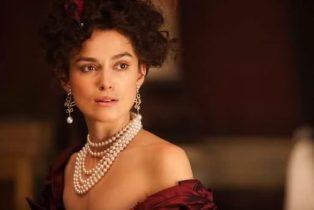
Keira Knightley as Anna Karenina (moviehole.net)
In Leo Tolstoy’s 800-page novel Anna Karenina, the standards of Imperial Russian society in the years 1874-1877 (the author set the story contemporaneously with his writing) were in flux. Rather than staying with traditional Eastern Orthodoxy, they were leaning towards those of Western Europe, to include the language and fashions of Third Republic France as well as the moral high ground dictated by England’s Queen Victoria.
Becoming more than tolerant of clandestine affairs, but to a strictly limited degree (much like Hollywood itself at its peak), the Russian ruling class tended to overlook these romantic transgressions which, in spite of their nature (and the nature of their transgressors), were to be conducted at all times with the utmost decorum.
The various participants would go about their amorous activities delicately and discretely – a duplicitous situation, one might add, even hypocritical. Yet ironically, this arrangement granted both parties a certain freedom of movement. More significantly, it gave them the ability to save face while continuing to mingle in and out of polite society, as long as they played by that society’s “rules.”
There have been several film and television adaptations of Tolstoy’s classic story, with most of them playing by the cinema’s own well-established “rules.” Scenes of snowy winters, lavish ballrooms, gorgeous gowns, bustling railway stations, lush music scores (in the Doctor Zhivago mold, one presumes) and the like were the expected norm for such features.
Despite the potential for soap-opera antics, the story’s had widespread appeal for viewers. People want to know what happens to poor Anna, her youthful lover and their illicit relationship, not to mention what becomes of her husband and family.
Welcome to 2012, folks, and the latest, most elaborate, and least rule-bound movie version to date, which may or may not be a good thing for Tolstoy (or for us). The first line of his novel reads simply: “All happy families are alike; each unhappy family is unhappy in its own way,” which says a lot about the state of familial unions in those times. The same applies to those so-called “happy” families, but the principal “unhappy” figure in the Karenin household – and in most screen adaptations – is the titular Anna.
A rich society woman, probably in her early-to-mid 30s, Anna is married to the humdrum and plainly dispassionate government official Alexei Karenin. Karenin is generally taken by an older, established screen veteran – someone along the lines of South African-born Basil Rathbone in 1935, for example; wise, old Ralph Richardson in the Vivien Leigh version from 1948 (a dry run for his role as Olivia de Havilland’s father in The Heiress a year later); or the snooty James Fox in Sophie Marceau’s incredibly bland take from 1997.
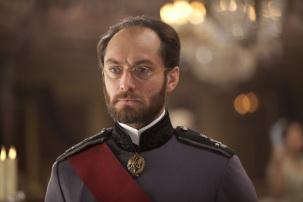
Jude Law as Karenin (wordandfilm.com)
Jude Law, at the youngish age of 40, is the “older, established screen veteran” in this, the most recent film variation of Anna Karenina’s themes by director Joe Wright, with a script by veteran screenwriter Tom Stoppard. For his part, Law brings a righteous indignation to the role. A paragon of virtue, the complacent Karenin exemplifies stodgy respectability in all its dull formality. Individuals in his class were expected to follow certain guidelines – and woe to the person who so much as attempted to deviate from them.
While visiting Moscow to help smooth over a serious situation that’s developed between her brother Stiva Oblonsky (another government official, congenially played by the boisterous Matthew Macfadyen) and his wife Dolly (Kelly Macdonald), Karenin’s wife Anna (Keira Knightley) meets and falls in love with a dashing cavalry officer, the womanizing Count Vronsky (Aaron Taylor-Johnson).
At the same time, the forlorn Konstantin Levin (Domhnall Gleeson), a childhood buddy of Oblonsky’s and a genuine back-to-the-land type (Cineaste magazine, in its review of the film, refers to him as a “proto-hippie,” which is right on the mark), has idealistic notions of marrying the much younger Kitty (Alicia Vikander), who’s attracted by the dubious attentions of the fair-haired Vronsky. We even get to meet Levin’s dissipated older brother, Nicolai, and his prostitute spouse, Masha. That’s a hefty mouthful of vodka-flavored transgressors to absorb at one sitting.
Be that as it may, Anna’s tempestuous and ongoing association with Vronsky represents the “passionate, physical side of love,” at least according to Ms. Knightley, whose third collaboration (after Pride and Prejudice and Atonement) with director Wright this happens to be.
Wright notes that Anna Karenina is “an epic story, a story of love in its many forms.” His statement is confirmed by Stoppard (Rosenkrantz and Guildenstern are Dead, Shakespeare in Love), in his observation that “love is always a topic… There’s Levin’s love for Kitty, the love between siblings, love between Kitty and Dolly, love of Russia.” Mr. Stoppard has reduced the novel, in which Anna and Vronsky are but one of several couples in crisis mode, to “the essence of what Tolstoy was really on about, and that is the exploration of different aspects of love.”
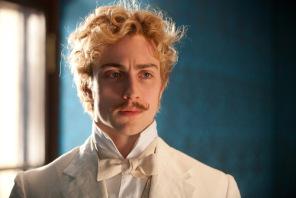
Aaron Taylor-Johnson (wehearit.com)
In both the novel and the movie, Anna and her lover Vronsky (an unimpressive, and ergo out-of-his-depth Taylor-Johnson, in a role normally played by such gallants as John Gilbert, Fredric March, Kieron Moore, and Sean Bean) carry on their torrid affair under everyone’s watchful but knowing eye. Yet, as Ms. Knightley tellingly discerns for us, “When love gets purely carnal” (as it most evidently does here), “you can get punished.” Oh, how right she is!
We are alerted to that possibility early on, as Karenin (balding, bearded and bespectacled Mr. Law) expresses his doubts to Anna about her mission to Moscow, which concerns getting sister-in-law Dolly to forgive her reprobate brother’s indiscretion with a lovely young governess.
Karenin reluctantly agrees to let Anna go, but not without wagging his accusatory finger at the issue: “I’m to be deprived of my wife so that adultery may be forgiven? I can’t excuse him just because he’s your brother.”
“Do you think nine years of marriage and children should count for nothing against a… an infatuation?” counters Anna.
“No,” Karenin replies. “Very well. But sin has a price, you may be sure of that,” he offers in response (and how right he is, too!). Anna gives him the barest hint of a smile, in her mind dismissing his remark as more of her husband’s stuffy pontificating.
She succeeds in getting Dolly to take Stiva back into her good graces, never realizing that her own situation later on cannot possibly be forgiven, or that she could never be taken back in the same way her brother had been, by a spouse who puts morality and propriety (along with his political career) above marital bliss. “The married fallen woman receives even less sympathy, for no one will grant forgiveness to the wife and mother who betrays her family,” as was noted in Part Two.
As the story develops, Anna and Vronsky are given the “freedom” to co-habitate together. However, Anna is subtly and deliberately ostracized by society. She cannot be received by anyone who is anyone, either in Italy, in St. Petersburg (where Karenin and her son Seryozha reside), or in Moscow proper. Vronsky, on the other hand, is free to come and go as he pleases, which spells doom for their volatile relationship, as Anna’s state of mind starts to unravel.
Amid the emotional turmoil, she begins to have doubts about Vronsky’s fidelity. She eventually gives in to suspicion and despair, imagining all sorts of secret trysts he may or may not be having with the latest society conquest to arrive in town. Despondent, alone, and unable to stay with Vronsky, or to return to her husband – or even be with her son – Anna puts an end to her miserable life by throwing herself under the carriage of a passing train.
“Forgive me,” she cries as the train tramples her body. Did we say “soap-opera antics”?
The Lavish Look of Love
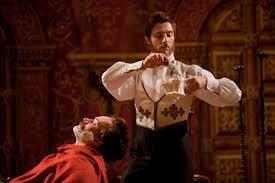
Matthew Macfadyen (left) as Oblonsky (artsjournal.com)
This latest film adaptation of Anna Karenina, quite unlike any other, is a highly stylized affair. From its opening scene in a makeshift theater, where an unseen orchestra tunes up and the solitary figure of Oblonsky receives an impossibly close shave and vigorous facial massage, one gets the feeling this tale would “play” better as a stage vehicle rather than as an all-out motion picture production.
Most of the plot takes place inside this theater, built specifically by the set designers and supervised by production designer Sarah Greenwood, for that purpose. “Framing it in this derelict theater was a fantastic concept,” claimed Greenwood for the U.K. paper The Guardian, “given the theatricality of high society in St. Petersburg and Moscow at the time.”
Keira Knightley, who has the dark looks, pent-up passion, physique du rôle, and forthright manner of the tragic heroine, possesses the unique ability to wear her elegant costumes as if to the manner born.
“Since she was young, Keira has always understood the importance of costume as part of character,” said Oscar-winning costume designer Jacqueline Durran. “This is rare in an actress, believe me. She’s even got the gumption to turn the costume department’s ideas down and come up with sketches of her own.
“We’ve loved researching this together,” Durran continued. “As the Russian aristocrats were obsessed with French culture in the nineteenth century, we just came up with the idea of tweaking it a bit and using the heyday of couture from the 1950s to emphasize Anna’s modern streak. Some people will notice, others won’t. But it really helped Keira understand Anna.”
With perfect alabaster skin and well-developed back muscles (evident in the masterfully directed and choreographed waltz sequence, discussed below), Ms. Knightley stood poised to become a truly great Anna. If only the above combination of costumes, staging, dancing and acting led to a more memorable performance; and if only the finished film product didn’t let its lead actress down.
Keira flirts, Keira pouts; Keira furrows her brow and wrinkles her nose at the slightest provocation, all to no avail. Ultimately overwhelmed by the overly stylized, theatrically-based conception of late nineteenth-century Russian social mores, Knightley’s Anna gets lost in director Wright’s vision of Stoppard’s compact screenplay.
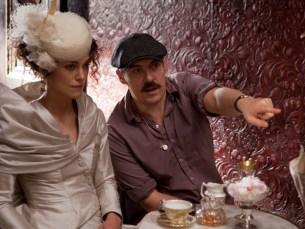
Keira and Joe Wright (salon.com)
“She’s developed incredibly as an actress and human being and she’s really strong now,” marvels Wright. “It would have been so easy [for her] to bugger off to Hollywood where they’re all nice to her. But she dug her heels in and worked really, really hard.”
And it shows, but was the extra effort Knightley put in really, really worth the trouble? That’s for audiences to decide, but this audience member remains unconvinced. Not that Keira herself lacked passion or commitment; it’s that this kind of venture lacked spontaneity, what with the actors being rehearsed to death over a three-week period prior to actual shooting.
That’s the impression I got, and it’s a difficult one to shake. We immediately cease caring about Keira’s plight since the character she portrays shows so little concern for her own son’s welfare – which is the exact opposite of Greta Garbo’s tormented depiction back in 1935 (her scenes with young Freddie Bartholomew as Seryozha are tender and heartbreaking, and beautifully rendered by both actors). Wright’s picture loses steam (no pun intended) long before that railroad train runs Anna over.
As Vronksy, Aaron Taylor-Johnson seems much too young and inexperienced for the role of Anna’s worldly playboy lover and object of her passion. The sense one gets is of a boy being sent out to do a man’s job. My criticism is not leveled at Aaron’s relative youth, only his inability at this point in his career to suggest the ulterior motives of a young roué behind the handsome façade.
Matthew Macfadyen, who played Mr. Darcy to Keira’s Libby Bennet in Pride and Prejudice, is a jolly Stiva indeed, the life of any party, an oversized Russian-bear of a fellow, which complements the character’s actions so completely. Oblonsky lives by the credo “paperwork is the soul of Russia,” which is the best line in the movie. But he’s not a major player nor is he the one to carry the burden of this production’s faults.
Only Jude Law – sensitive, aristocratic, yet at the same time aloof to the emotional needs of his wife – survives the mannered treatment in a skillfully judged portrait of Anna’s sinned-upon husband. He’s in love with the idea of marriage, and the political benefits of a “good” marriage to the “right” woman.
Domnhall Gleeson’s Levin, who we are told in one of the many superficially short and frustratingly uninformative “making-of” features, is the heart and soul of the novel. He’s played here as a distant, philosophically minded soul. While the character is supposed to be a stand-in for the aristocratic Tolstoy himself, who in real life freed his serfs and gave up his riches so that he could live off the land, in practice his Levin is a socially awkward clod.
Alicia Vikander’s Kitty is bubbly and charming and has more smarts than she’s given credit for. Her feelings for Levin are genuine and true, as are Dolly’s pain and hurt for Oblonsky’s ill treatment of her. Kelly Macdonald brings sensitivity and understanding to Dolly, but both characters have been given so little screen time that their presence along the periphery of the film’s multiple story lines begs the question as to whether this is more of a Reader’s Digest distillation of the novel or an imaginative retelling of it.
Dance and the World Dances with You
The film’s choreography, which is the stellar work of Sidi Larbi Cherkaoui – a Belgian choreographer of Moroccan descent who was inexplicably snubbed by not appearing, or even being mentioned, on the deluxe Blu-ray Disc edition – reminds me of the works of Michael Powell and Emeric Pressburger, presumably The Red Shoes and The Tales of Hoffmann. Both were highly stylized visions in and of themselves, but stemming from purely cinematic aspects and stressing the fantasy elements over the more realistic ones.
In Anna Karenina, we have the opposite occurring. The co-called “dance concept” favored by director Wright short-changes the film, as if the filmmaker had trouble making up his mind as to whether he wanted a play with music or “a ballet with words,” as Wright told the New York Times.
From the spectator’s point of view, this concept can be frustrating in the extreme. In fact, it defeats the purpose of the film-going experience. Why not make it a filmed play and dispense with all those “theatrical” trappings, thus avoiding pretentiousness altogether? This was the feeling I had when watching Tom Hooper’s The King’s Speech (2010). It was a marvelous production and a superb acting tour de force for both Colin Firth and Geoffrey Rush. But how much better they would be if they could do it on the stage, for which the script was originally intended!
In this version of Anna Karenina, the suspension of disbelief so necessary to making these ideas pass muster on the screen almost always works best in the theater, and under precisely calibrated theater conditions – not on sound stages built up to look like a theater. Ultimately, some sequences end up looking rather silly and (there goes that dreaded word again) slightly pretentious.
Here, a waltz is not a waltz, although it may look like a waltz. The costumes may dress the drama in a way the other elements – sets, props, physical layout, mise-en-scène – do not. Still, there’s almost too much story in Anna Karenina but not enough exposition to warrant it. The barest kernel of Tolstoy’s ethos is present, but not nearly enough of it, not when we compare the earlier and better screen embodiments, 1927’s Love and the 1935 MGM version, both with Greta Garbo, to this one.
Some scenes work remarkably well in Wright’s version, while others fall flat. Sets are pushed in and pushed out, much as they would be in a live production. But gimmicky scene changes that in the theater would be more than acceptable, on film break the fourth wall and are unnecessary as well as distracting. It’s like being backstage at the Metropolitan Opera while the opera is being performed out in front. Except here, the opera is all around us; entrances and exits, comings and goings, what a nuisance! And it’s all for the express purpose of telling the story. Just don’t run into the performers, please (Ingmar Bergman executed this same stunt, but oh-so-much better, in his cinematic take on Mozart’s The Magic Flute, in 1974).

Vronsky and Kitty (Alicia Vikander) tapuz.co.il
Getting back to the dance portions of the program, the waltz (as interpreted in this instance) is a physical manifestation of the characters’ evolving emotions. Heavy breathing and gasping for breath are prominent on the soundtrack. Anna, in a stunning black outfit, decides to dance with Vronsky, who is in a white cavalry officer’s uniform. The other couples, frozen in time and space, are cutouts, mere puppets to be manipulated at the filmmaker’s whim (Wright acknowledges the handiwork and influence of his parents, who owned and operated a puppet theater in his youth).
Individualized and highly ornate hand gestures play an important role, with more breathing, dizzying camerawork, and rapid cutting adding to the emotional content. Vronsky and Anna’s newfound passion are juxtaposed against Kitty’s disappointment and resentment of Anna’s intervention in her waltz with the Count. Soon, the focus is entirely on Anna and her lover, as the other couples leave the dacne floor. The sequence ends with a foreshadowing of Anna’s suicide under the train tracks, both at the beginning of the film (with the accidental death of a railway worker) and at this point, with the ominous appearance of the steam engine directly behind her (done with mirrors, I’m told).
One of the things I tried to do while viewing this feature was to have a sense of which scenes helped the story along and which scenes hindered the telling of it. In theory, Wright’s decision to go the theatrical route was well founded and well played out — after all, there had been numerous productions of the work, all of them done the old-fashioned way. In practice, however, the result was far from convincing.
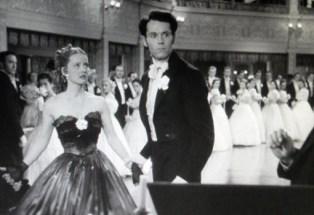
Bette Davis and Henry Fonda in Jezebel (examiner.com)
Ah, but that waltz sequence – it’s an absolutely stunning piece of choreography and a bravura piece of film-making where Wright’s ideas finally clicked into place. I kept thinking of a similar scene, one in George Cukor’s Jezebel (1938), where Bette Davis and Henry Fonda are on the dance floor at a “coming out” party for Davis and the other antebellum beauties. Davis flaunts convention, too, by wearing a scandalous red dress instead of the traditional white ballgown. No sooner do they begin to dance when Davis has second thoughts about her actions and asks to sit this one out.
Nothing doing! Fonda refuses to comply. He forces her to dance against her will and, in one of the cinema’s classic screen confrontations, disgraces himself and thoroughly humiliates Davis, who is ashamed of her bold behavior. One couple after another drops out of the dance, refusing to be seen on the same floor with them. Soon, Fonda and Davis are left to fend for themselves — it’s pure torture all around. When the music comes to an abrupt halt, Fonda twice insists with the conductor to “Go on and play.” The scene is helped immeasurably by Max Steiner’s expertly timed score and dramatic sensibilities.
Speaking of which, the music for Anna Karenina is in the hands of Italian-born Dario Marianelli, a composer whose work I’ve been hearing a lot of lately. Not only has he done scores for both Wright and Knightley’s previous efforts, but he’s also provided the music for Terry Gilliam’s The Brothers Grimm along with Cary Fukunaga’s Jane Eyre – a film I very much enjoyed and admired.
The score is effective and workmanlike, employing a variety of Russian folk themes, in particular one by Tchaikovsky for his Fourth Symphony (which formed the basis for the bogus opera, “The Masked Prince of the Caucasus,” in one of the sequences from Universal’s Phantom of the Opera from 1943). Otherwise, it’s too pretty by half and adds little to the film’s dramatic impact, despite being lovely to listen to.
To be able to tell a story clearly and methodically, whether linearly or not, is the least a film can do to help audiences grasp its inner meaning. Much like Imperial Russian society, rare indeed are the films that can flaunt conventions and give us true insight into their story line via non-conventional means. We must keep in mind, too, that the standards of modern cinema are today in constant flux, and will be for years to come.
I praise Wright’s attempt at something different and the courage it took for him to execute it. With the exception of that lone waltz sequence, however, the effort put into Anna Karenina pays off only intermittently and in kopeks, not in dollars — which is punishment enough for his transgressions.
In the end, like Anna herself, a fallen woman who literally falls onto the train tracks to end her short but trouble-filled life, we commit this latest movie version to a short shelf life of its own. To that I can only add: Do cvidanya!
Copyright © 2013 by Josmar F. Lopes

